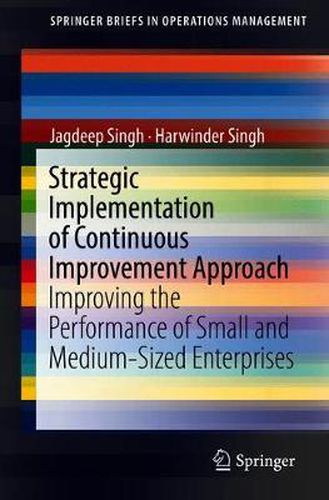Readings Newsletter
Become a Readings Member to make your shopping experience even easier.
Sign in or sign up for free!
You’re not far away from qualifying for FREE standard shipping within Australia
You’ve qualified for FREE standard shipping within Australia
The cart is loading…






This title is printed to order. This book may have been self-published. If so, we cannot guarantee the quality of the content. In the main most books will have gone through the editing process however some may not. We therefore suggest that you be aware of this before ordering this book. If in doubt check either the author or publisher’s details as we are unable to accept any returns unless they are faulty. Please contact us if you have any questions.
This book covers the strategic use of continuous improvement (CI) techniques for manufacturing performance improvement. It focuses primarily on strategies that can be adopted by small and middle-sized enterprises in manufacturing in order to meet the global challenges and competition. The book begins with an introduction to CI (or Kaizen), explaining different CI approaches and strategies. Chapter 2 offers a literature review of CI, examining conceptual frameworks, case studies, and surveys. Next, the book deals with the design of the study, detailing the work done in each phase along with the tools, techniques and models. Chapter 4 presents a detailed survey to determine the present status of continuous improvement strategies in the Indian manufacturing industry, to assess the important barriers that effect the implementation of CI strategies, and to also assess the role of key enablers leading to improve the performance of manufacturing operations. Chapter 5 is comprised of detailed case studies to further analyze the application of the discussed CI strategies. The purpose of Chapter 6 is to develop the relationship among the different identified most important barriers in implementing CI approach using interpretive structural modeling (ISM) and classify these barriers depending upon their driving and dependence power. Finally Chapter 7 provides conclusions, addresses potential limitations, and also looks to the future.
$9.00 standard shipping within Australia
FREE standard shipping within Australia for orders over $100.00
Express & International shipping calculated at checkout
This title is printed to order. This book may have been self-published. If so, we cannot guarantee the quality of the content. In the main most books will have gone through the editing process however some may not. We therefore suggest that you be aware of this before ordering this book. If in doubt check either the author or publisher’s details as we are unable to accept any returns unless they are faulty. Please contact us if you have any questions.
This book covers the strategic use of continuous improvement (CI) techniques for manufacturing performance improvement. It focuses primarily on strategies that can be adopted by small and middle-sized enterprises in manufacturing in order to meet the global challenges and competition. The book begins with an introduction to CI (or Kaizen), explaining different CI approaches and strategies. Chapter 2 offers a literature review of CI, examining conceptual frameworks, case studies, and surveys. Next, the book deals with the design of the study, detailing the work done in each phase along with the tools, techniques and models. Chapter 4 presents a detailed survey to determine the present status of continuous improvement strategies in the Indian manufacturing industry, to assess the important barriers that effect the implementation of CI strategies, and to also assess the role of key enablers leading to improve the performance of manufacturing operations. Chapter 5 is comprised of detailed case studies to further analyze the application of the discussed CI strategies. The purpose of Chapter 6 is to develop the relationship among the different identified most important barriers in implementing CI approach using interpretive structural modeling (ISM) and classify these barriers depending upon their driving and dependence power. Finally Chapter 7 provides conclusions, addresses potential limitations, and also looks to the future.